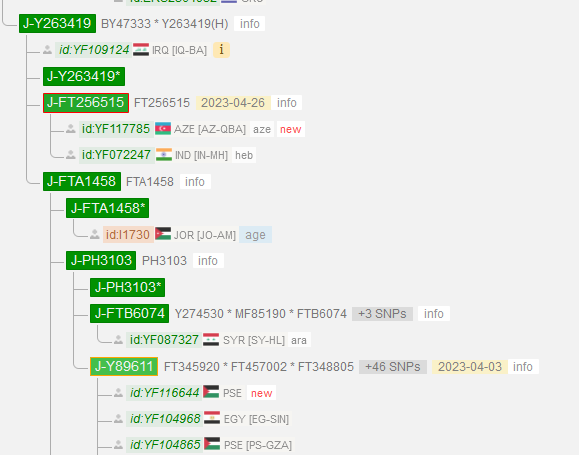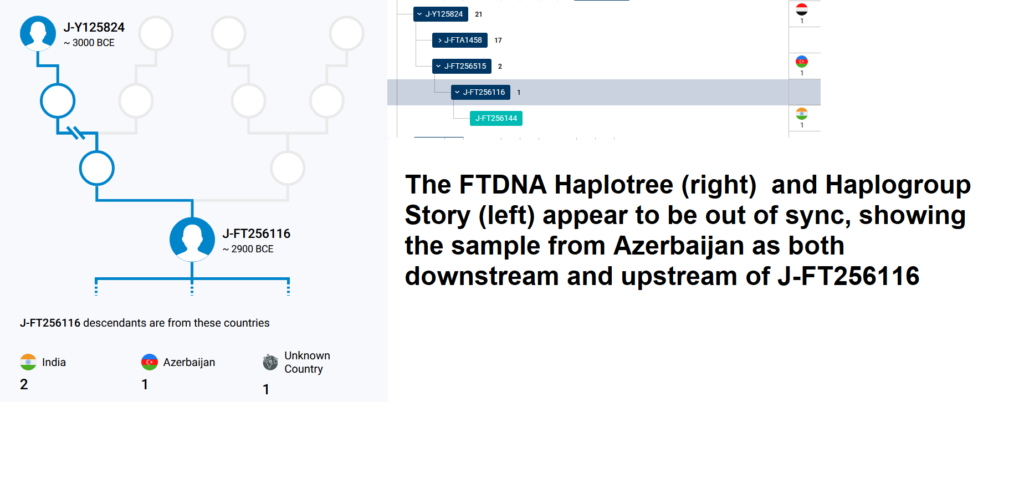In the prolific J2b-M205, which in various countries of the Middle East ranges between the single digits to over 70% in Socotra (YFull) there has been only one cluster of men, to my knowledge, who are NGS-tested and following a Jewish tradition.

Interestingly, these particular men happen to be extreme geographic outliers from the rest of their J2b-M205 distant cousins, tracing their male lines to India. I manage the sample on the YFull YTree and have used the regional code for Maharashtra because while this sample did not tell me from where in India he traced his male line, he has a STR match with another Indian Jew who indicated his male line traced to Samundrapur, in eastern Maharashtra.
According to the sample I manage on YFull, he learned that one of the other men in his STR cluster believes he descends from Cochin Jews.
There is an additional sample in this group, EB-16882, which is annotated as “Mumbai Bene Israel Jew” on Chris Rottensteiner’s J2 website.
I wonder if this EB-16882 might be the sample that appears hidden in the FTDNA Haplotree (it indicates just one customer from India) as an invisible sample appears to form a subclade with the Big Y customer called J-FT256144.
Quba, Azerbaijan sample forms new branch J2b-FT256515
YFull and FTDNA have very similar estimates for when the MRCA (Most Recent Common Ancestor) of the Azerbaijan – Jewish India samples lived, at 5000 and 4900 ybp respectively, that is 3000 and 2900 BCE.

However as of this writing (May 8, 2023) FTDNA is showing the Azerbaijan sample in two different, contradictory positions in its different tree views (below).

Thoughts on the geographic origin of J2b-FT256515
While Azerbaijan is a region where some lineages of J2b had been living in the Neolithic (a sample found in Mentesh Tepe belonging to the Shulaveri-Shomu culture was found in a recent study to be a line of J2b-Z2453), this is the first time that the particular line of J2b-M205 has been found there, at least among the NGS-tested sample set, to my knowledge.
I think the two main scenarios to consider regarding their common ancestors’ geographic origin are that the sample from Azerbaijan represents geographic continuity of the ancestral origin vs his being a later migration from further south, where we see more J2b-M205 diversity.
A variation of the second scenario is one where the sample from Quba, Azerbaijan descends from Mountain Jews, though I should state that this sample has not indicated Judeo-Tat as his male line’s language, rather Azerbaijani. After getting a hint from another researcher from the YFull messaging system, I read from the Wikipedia article that the main settlement of Mountain Jews in the Azerbajian was Qırmızı Qəsəbə, which is indeed in Quba province.
I’m not aware if this sample has any STR matches or who they are.
If his ancestors really were Mountain Jews, then we have a very interesting set of coincidences – that two men descending from the same man who lived 5000 years ago, well before written records of Judaism, ended up both becoming Jews later. If their common ancestor lived in the Levant (or whose ancestor came from there) vs in or around Iran or Iraq, then there is an additional coincidence – that both lineages, or the ancestor of both coincidentally migrated back to the east, closer to the Neolithic origins of J2b.
One of this lineage’s next closest cousins is the ancient sample I1730 from Ain Ghazal, Jordan dating to about 2400 BCE, so if this cousin line could have been living there in the Bronze Age, so could J2b-FT256515 have.
Not being a subject matter expert in the history of Jewish peoples, I prefer to be agnostic regarding this aspect of the second theory. Though I favor a more recent migration to Azerbaijan as more likely than the sample being indicative of the ancient origin of J2b-M205. We should keep in mind that the sample from Quba didn’t indicate on YFull a Judeo-Tat male line oral history. So his ancestor may have simply come from the direction of Iran and not have been a Jew.
When more ancient samples are found and if the sample from Azerbaijan eventually finds closer relatives, we may be able to more reliably exclude certain possibilities regarding the ancient origins of each line.
J2b-FT256116 Mystery man on FTDNA tree
There is an additional sample visible on the FTDNA tree as being more closely related to the Jews of India than to the sample from Azerbaijan, however this sample has unfortunately not set his country code on FTDNA, so it doesn’t help the public research.
This sample is only missing 4 of the SNPs that the two Indian Jews are positive for. So he would only be a few hundred years more distantly related to them than they are to each other.
Determining where he traces his male line would be helpful for resolving the deeper origin of these men and narrowing down the time frame for when the migration to India may have taken place, of an ancestor who I assume would have been a Jew before migrating to India, because Judaism is an exogenous religion to India and coming from the same relative direction as J2b-M205.
These posts are the opinion of Hunter Provyn, a haplogroup researcher in J-M241 and J-M102.